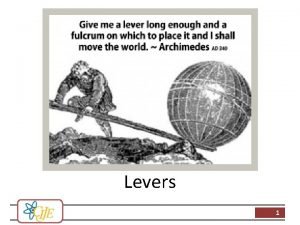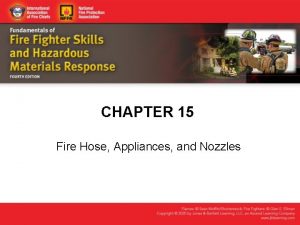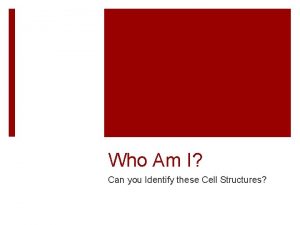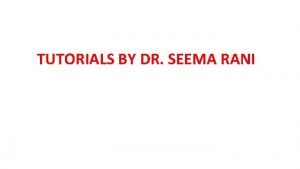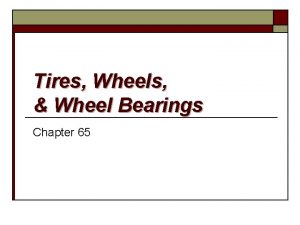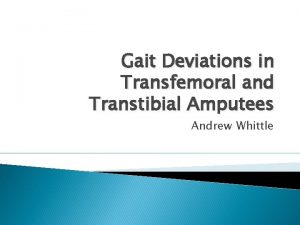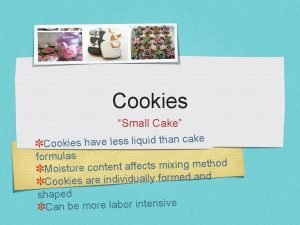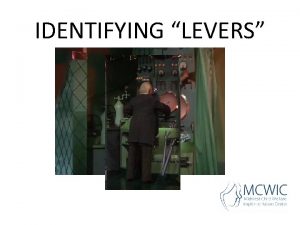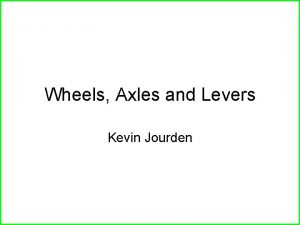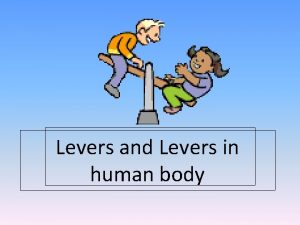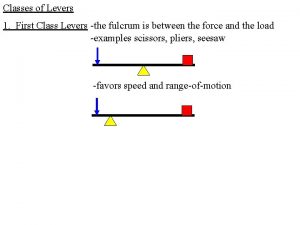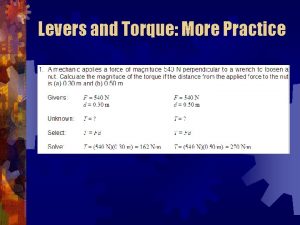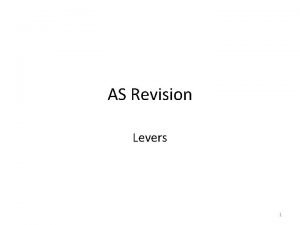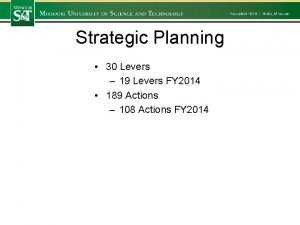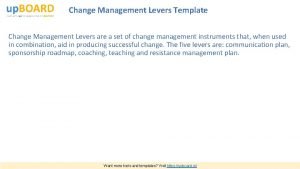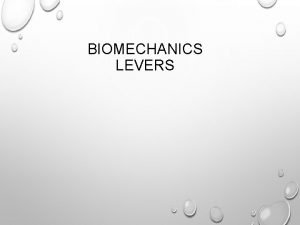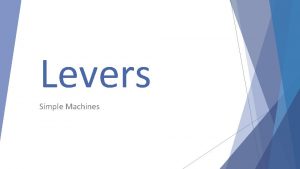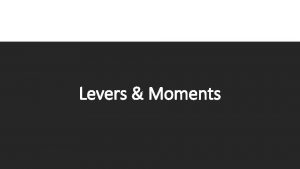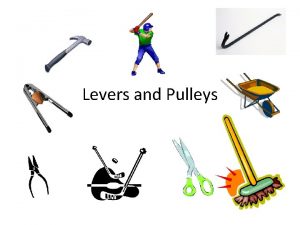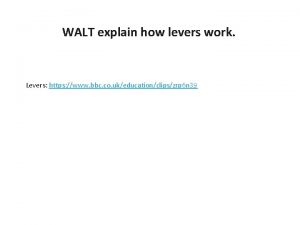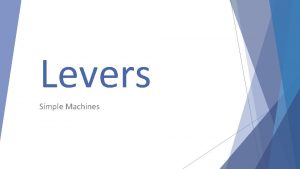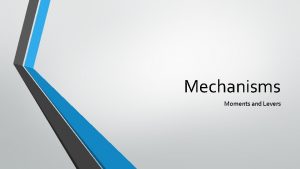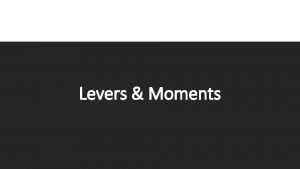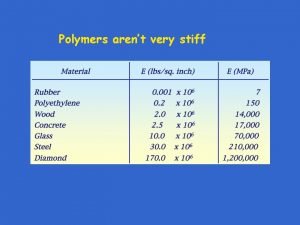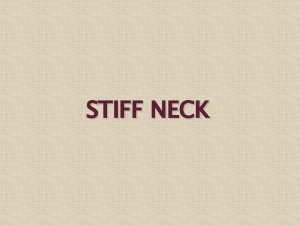Levers 1 Levers A stiff structure that rests























- Slides: 23

Levers 1

Levers • A stiff structure that rests on a turning point called the fulcrum • Used to change the amount, the strength and the direction of movement. • The position of the force and the load can be changed by moving them to different points on the lever. 2

3 Classes of Levers Class 1 Class 2 Class 3 • The class of lever is determined by the location of the Fulcrum, Force and Load 3

1 st Class • The load force and the effort force are separated by the fulcrum • As one moves up the other moves down. • The amount and the strength of the movement depends on the distance from the fulcrum 4

2 nd Class • The load force is between the effort force and the fulcrum. • This lever uses mechanical advantage to make moving large weights easier. • A small force by the effort can move a large load force • Gives Mechanical Advantage 5

3 rd Class • The effort force is between the fulcrum and the load. • Mechanical advantage is reduced but more movement is possible. • A small movement by the effort results in a larger movement of the load • Gives speed and distance advantage 6

Summary 3 Classes of Levers 7

Summary Examples In The Human Body 8

Lever Systems • Effort Arm – The part of the lever to which the effort force is applied. • Effort Distance – The length of the Effort Arm, from the fulcrum to the effort end of the lever. • Resistance Arm – The part of the lever on which the resistance force is exerted. • Resistance Distance - The length of the resistanace arm, from the fulcrum to the resistance end of the lever. 9

Lever Systems A. Lever C. Resistance Distance E. Effort Arm G. Effort Distance B. Fulcrum D. Resistance Force F. Effort Force H. Resistance Arm F G C E D A H B 10

Moment • A ‘moment’ is the ability of force to turn the body to which it is being applied • The moment is calculated by multiplying the force times its distance from the fulcrum 11

Moment • For a lever to be balanced, all of its moments must add up to zero F 1 • d 1 = F 2 • d 2 • If one moment is greater than the other, the lever will be rotated towards that force 12

Moment - Examples • Since the two moments are equal the lever is in equilibrium, and balanced 10 • 1 = 5 • 2 13

Moment - Examples • What force would need to be placed on the force arm to put the lever into equilibrium? 80 • 9 = x • 12 14

Moment - Examples • What force would need to be placed on the force arm to put the lever into equilibrium? (20 • 10) + (30 • 5) = x • 10 15

Effective Angle • To balance a lever, the effort force must be applied perpendicular to the lever • A force applied parallel to the lever only forces the lever into the fulcrum and produces no moment. 16

Effective Angle • A force applied perpendicular to the lever applies all of its force to the moment • When applied at an angle, some results in a moment and some is ‘wasted’, or called a stabilizing force 17

Summary • Levers are used to change the amount, the strength and the direction of movement • There are 3 classes of levers • The class is dependent on the location of the fulcrum with respect to the effort and loads • A moment is produced when a force is applied to a lever • The strength of the moment is dependent on the force’s distance from the fulcrum and the angle at which the force is applied to the lever 18

Levers in the body 19

Levers in the body 20

Levers in the body • As the elbow rotates, the bicep muscle is constantly changing its angle relative to the arm (the lever) • This changes the amount of moment the bicep can produce to lift a load • The force the muscle can produce also changes as it stretches past its ideal length 21

Levers in the body • The graph shows the moment produced by the bicep relative to the elbow angle • The largest moment is produced when the elbow is at 90° • This is also when the load on the arm is greatest, when an object is farthest away from the body 22

23
 Picture of screw simple machine
Picture of screw simple machine Where is lever in our body
Where is lever in our body Phân độ lown ngoại tâm thu
Phân độ lown ngoại tâm thu Block nhĩ thất độ 2 mobitz 2
Block nhĩ thất độ 2 mobitz 2 Thể thơ truyền thống
Thể thơ truyền thống Thơ thất ngôn tứ tuyệt đường luật
Thơ thất ngôn tứ tuyệt đường luật Chiến lược kinh doanh quốc tế của walmart
Chiến lược kinh doanh quốc tế của walmart Tìm vết của đường thẳng
Tìm vết của đường thẳng Hãy nói thật ít để làm được nhiều
Hãy nói thật ít để làm được nhiều Tôn thất thuyết là ai
Tôn thất thuyết là ai Gây tê cơ vuông thắt lưng
Gây tê cơ vuông thắt lưng Sau thất bại ở hồ điển triệt
Sau thất bại ở hồ điển triệt Acts 7 51 53
Acts 7 51 53 It is a line of a dress or the garments overall shape
It is a line of a dress or the garments overall shape Stiff mud process
Stiff mud process Which type of valve is typically used on engine discharges?
Which type of valve is typically used on engine discharges? Storage container of pigment in cell
Storage container of pigment in cell My name means colored bodies
My name means colored bodies I spy simple machines
I spy simple machines Patrick stiff md
Patrick stiff md Who was the long awaited friend of anne frank
Who was the long awaited friend of anne frank Safety ridges wheel
Safety ridges wheel Transtibial gait deviations
Transtibial gait deviations Rolled cookies are made from a stiff dough
Rolled cookies are made from a stiff dough

